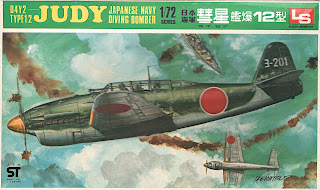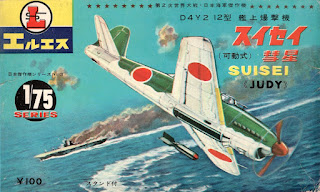Back to IJN floatplanes and a hat tip to Aviation of Japan's Texas correspondent Mark Smith for alerting to this remarkable 1/72 scale US Navy aircraft recognition model of an Aichi E13A1 'Jake' in the National Air and Space Museum (NASM) collection. The model reportedly dates to 1943 and is of wood construction with a clear plastic canopy. It was transferred to NASM custody from the US Department of the Navy, Office of the Assistant Secretary of the Navy. Sharp eyes may note that it includes a crew of three figures and panel lines are represented. Mark suggests that this appears to be the type of model photographed from various angles for the images to be included in recognition books.
Apart from the obvious errors in the form of the canopy it is arguably a better representation of 'Jake' than the venerable Hasegawa kit! Mark has speculated that the model may originate from studies of the first aircraft of this type to be captured. He writes as follows:-
'Being built in 1943, that charming model is a reference in itself. Recognition models often don’t look right because the markings are not correctly placed and the colors are an afterthought. Here every color seems carefully considered And while there is no way to be sure of this, I would not be surprised if the colors were of Japanese origin from captured stocks, sent to Washington. I would never make that claim, but it’s an interesting possibility.
'The markings reflect the two Jake hulks that were measured and photographed carefully by American intelligence, so I would imagine that is the source of its accuracy. The one place where this fails is the canopy: its unique windscreen with its cut back angle, the rear section, and the framing itself. I think this is due to the fact that the canopies were probably not present on the wrecks. At least I don’t remember seeing them though I do recall some nice shots of the pilot’s cockpit, although it was stripped of much equipment - I forget whether those were found at Attu or Kiska. The only sign that I could see of any damage or missing part was one of the float Rudders gone.'
The colours are convincing. The 'warm' grey under surfaces are to be noted and can be compared to the 8609 2-6 (post J3) colour shown in an October 2023 blog from L*a*b* measurements of the original swatch by the Japanese Aeronautic Association. The upper surfaces appear similar to D1 Deep Green Black although a wipe over with vegetable oil might reveal a slightly richer green colour closer to D2 Green Black. The Hinomaru colour appears spot on. The 'MI' tail code is associated with the minelayer Okonoshima. Markings details extend to the tailplane drift lines and the float pontoon stripes but note the absence of yellow wing leading edge IFF strips which does suggest an early to mid-1942 aircraft. The dimensions of the model are 5.1 x 15.2 x 20.3cm (2 x 6 x 8 in).
With special thanks to Mark for a most interesting and intriguing discovery and to NASM for preserving and photographing the model
Image credit: NASM Collection, Inventory # A19470046000













































